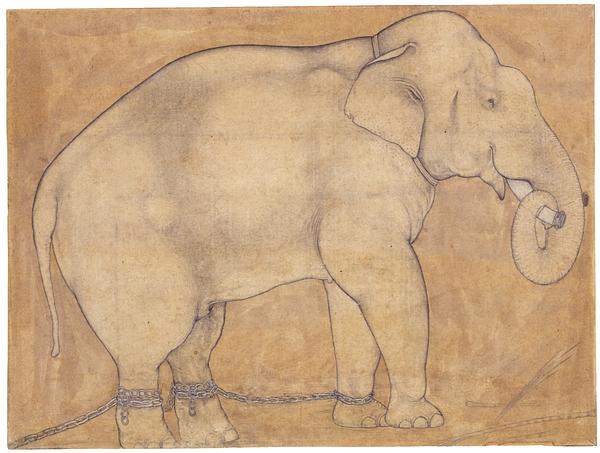Partly colored drawing. ‘A Chained Elephant’
India, Mughal; 1625-1630
Drawing: 18 × 24 cm
Elephants were always highly prized by the Indian princes. The Great Mughal Akbar’s biographer, Abu’l-Fazl, describes the inmates of the princely stables in detail, lists their various qualities and the cows’ gestation period, and notes that a good elephant is just as valuable as 500 horses.
The Great Mughal Jahangir was known for his profound interest in nature, both flora and fauna, and his artists made skilled portraits of both man and beast. The depiction of an old, chained, almost white bull elephant is masterful, and leaves no one in any doubt about its wisdom and craftiness.
Elephants were used in processions, for tiger hunts, and for war, and while the prince himself sat in a howdah on the animal’s back, it was controlled by a mahout, straddled on its neck.
Inv. no. D 4/1994
Published in:
Karl Madsen: ”Kobberstiksamlingens indiske tegninger” in Kunstmuseets Aarsskrift, 1916:3, p. 17 + ill.;
Gustaf Munthe: Orientaliska miniatyrer och manuskript: katalog med konsthistorisk inledning, Röhrska Konstslöjdmuseet and Det danske Kunstindustrimuseum, København 1929, cat.no. 73 (no photo);
Kjeld von Folsach, Torben Lundbæk and Peder Mortensen (eds.): Sultan, Shah and Great Mughal: the history and culture of the Islamic world, The National Museum, Copenhagen 1996, cat.no. 327;
Kjeld von Folsach: Art from the World of Islam in The David Collection, Copenhagen 2001, cat.no. 70;
Kjeld von Folsach: For the Privileged Few: Islamic Miniature Painting from The David Collection, Louisiana, Humlebæk 2007, cat.no. 103;
